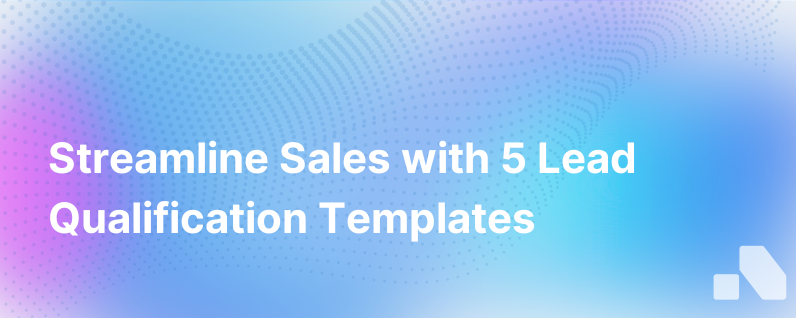
For sales professionals, one of the most critical stages in the sales process is lead qualification. It's the meticulous vetting procedure that determines whether a prospect is a good fit for your product or service — essential for any efficient sales strategy. But often, judging the quality of a new lead means balancing speed with thoroughness.
Incorporating lead qualification templates into your sales process can be a game-changer. When every second counts, these ready-to-go frameworks can be instrumental in streamlining decision-making and improving overall sales efficiency. Here's an insightful guide on five tried-and-true lead qualification templates specially designed to make your life easier.
1. BANT Lead Qualification Template
BANT stands for Budget, Authority, Need, and Timeline — a time-honored system created by IBM decades ago, yet it remains one of the most effective ways to qualify leads.
Budget:
- Is there a clear budget assigned for a solution?
- Can your product/service fit within their spending limitations?
Authority:
- Is the contact authorized to make the purchasing decision?
- Have all decision-makers been identified?
Need:
- Is there a definitive need for your product/service?
- How does addressing this need rank in their priorities?
Timeline:
- Is there a specific timeline for implementation and purchase?
- When are they planning to address the need they have outlined?
2. CHAMP Lead Qualification Template
While BANT puts the budget first, CHAMP shifts the focus to challenges. It stands for Challenges, Authority, Money, and Prioritization.
Challenges:
- What hurdles does the potential client face?
- How can your solution help overcome them?
Authority:
- Who will make the buying decision, and who else will influence it?
- How can you engage with the decision-makers directly?
Money:
- What funds are available to the prospect to solve their challenge?
- In case of insufficient funds, are there alternative means of financing?
Prioritization:
- How urgently does the prospect need to solve their challenge?
- Where does the solution fall on their list of priorities?
3. ANUM Lead Qualification Template
ANUM prioritizes authority, ensuring that you're talking to the decision-maker(s) as soon as possible. ANUM stands for Authority, Need, Urgency, and Money.
Authority:
- Do you have access to the decision-maker?
- If not, how can you get connected to the person with authority?
Need:
- What are the needs of the prospect?
- Does your offering align with their pain points?
Urgency:
- How pressing is their issue?
- Do they have deadlines driving their decisions?
Money:
- Do they have the budget, or can they acquire it to purchase your solution?
4. FAINT Lead Qualification Template
FAINT, a variation of BANT, acknowledges that prospects may not always have a set budget but could find the money if the value proposition is strong enough. It stands for Funds, Authority, Interest, Need, and Timing.
Funds:
- Does the prospect have potential funds available or the ability to allocate funds for a solution?
Authority:
- Are you in contact with the person who can green-light the acquisition?
Interest:
- Does the prospect show genuine interest in your product/service?
Need:
- Is there a clear use case for your solution within their organization?
Timing:
- When would they be ready to consider, decide on, and implement a solution?
5. GPCTBA/C&I Lead Qualification Template
This template is particularly thorough, created by HubSpot, and stands for Goals, Plans, Challenges, Timeline, Budget, Authority, Negative Consequences, and Positive Implications.
Goals:
- What goals is the lead targeting with a potential solution?
- How do these goals align with what you can provide?
Plans:
- What plans does the prospect have in place to achieve those goals?
- Can your solution integrate into those plans?
Challenges:
- What are potential obstacles in the way of their goals?
- Is your solution adequately equipped to handle these challenges?
Timeline:
- What is the expected timeline to achieve these goals?
- Does this correlate with the sales cycle of your product/service?
Budget:
- Will they be able to allocate the budget for your solution?
- How can you help justify the necessary spend?
Authority:
- Who needs to sign off on the purchase?
- How can you target communication with these individuals?
Negative Consequences:
- What happens if the prospect fails to act and solve their challenges?
- How can framing these consequences help qualify the lead?
Positive Implications:
- What are the positive outcomes from acting and purchasing a solution?
- How can highlighting these benefits help in the qualification process?
Conclusion
Lead qualification is the art of converting prospects into potential customers, but it's a fine art that requires an understanding of which prospects merit the direct investment of your valuable time and effort. Preparing a template allows you to quickly ascertain a lead's viability and position your product accordingly.
Effectively leveraging templates like BANT, CHAMP, ANUM, FAINT, and GPCTBA/C&I can provide a standardized and repeatable approach to qualifying leads, increasing your conversion rates and ensuring your team engages the right prospects at the right time.
Incorporate these templates into your CRM or use intelligent tools like Aomni to facilitate the necessary insight to apply these frameworks efficiently. By doing so, you'll ensure your sales teams work smarter, not harder, leading to streamlined processes, a fuller pipeline, optimized sales cycles, and ultimately, greater success in closing deals.